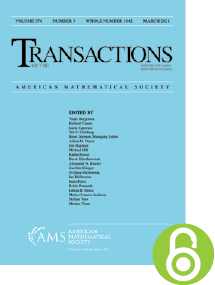Thin set theorems and cone avoidance
HTML articles powered by AMS MathViewer
- by Peter Cholak and Ludovic Patey PDF
- Trans. Amer. Math. Soc. 373 (2020), 2743-2773 Request permission
Abstract:
The thin set theorem $\operatorname {\mathsf {RT}}^n_{<\infty ,\ell }$ asserts the existence, for every $k$-coloring of the subsets of natural numbers of size $n$, of an infinite set of natural numbers, all of whose subsets of size $n$ use at most $\ell$ colors. Whenever $\ell = 1$, the statement corresponds to Ramsey’s theorem. From a computational viewpoint, the thin set theorem admits a threshold phenomenon, in that whenever the number of colors $\ell$ is sufficiently large with respect to the size $n$ of the tuples, the thin set theorem admits strong cone avoidance.
Let $d_0, d_1, \dots$ be the sequence of Catalan numbers. For $n \geq 1$, $\operatorname {\mathsf {RT}}^n_{<\infty , \ell }$ admits strong cone avoidance if and only if $\ell \geq d_n$ and cone avoidance if and only if $\ell \geq d_{n-1}$. We say that a set $A$ is $\operatorname {\mathsf {RT}}^n_{<\infty , \ell }$-encodable if there is an instance of $\operatorname {\mathsf {RT}}^n_{<\infty , \ell }$ such that every solution computes $A$. The $\operatorname {\mathsf {RT}}^n_{<\infty , \ell }$-encodable sets are precisely the hyperarithmetic sets if and only if $\ell < 2^{n-1}$, the arithmetic sets if and only if $2^{n-1} \leq \ell < d_n$, and the computable sets if and only if $d_n \leq \ell$.
References
- Peter A. Cholak, Damir D. Dzhafarov, Jeffry L. Hirst, and Theodore A. Slaman, Generics for computable Mathias forcing, Ann. Pure Appl. Logic 165 (2014), no. 9, 1418–1428. MR 3210076, DOI 10.1016/j.apal.2014.04.011
- Peter A. Cholak, Mariagnese Giusto, Jeffry L. Hirst, and Carl G. Jockusch Jr., Free sets and reverse mathematics, Reverse mathematics 2001, Lect. Notes Log., vol. 21, Assoc. Symbol. Logic, La Jolla, CA, 2005, pp. 104–119. MR 2185429
- Chris J. Conidis, Classifying model-theoretic properties, J. Symbolic Logic 73 (2008), no. 3, 885–905. MR 2444274, DOI 10.2178/jsl/1230396753
- Barbara F. Csima, Denis R. Hirschfeldt, Julia F. Knight, and Robert I. Soare, Bounding prime models, J. Symbolic Logic 69 (2004), no. 4, 1117–1142. MR 2135658, DOI 10.2178/jsl/1102022214
- François G. Dorais, Damir D. Dzhafarov, Jeffry L. Hirst, Joseph R. Mileti, and Paul Shafer, On uniform relationships between combinatorial problems, Trans. Amer. Math. Soc. 368 (2016), no. 2, 1321–1359. MR 3430365, DOI 10.1090/tran/6465
- Rod Downey, Noam Greenberg, Matthew Harrison-Trainor, Ludovic Patey, and Dan Turetsky, Relationships between computability-theoretic properties of problems, arXiv.org, March 2019.
- Harvey M. Friedman, Fom:53:free sets and reverse math and fom:54:recursion theory and dynamics, Available at https://www.cs.nyu.edu/pipermail/fom/.
- Marcia J. Groszek and Theodore A. Slaman, Moduli of computation (talk), Buenos Aires, Argentina, 2007.
- Carl G. Jockusch Jr., Ramsey’s theorem and recursion theory, J. Symbolic Logic 37 (1972), 268–280. MR 376319, DOI 10.2307/2272972
- Carl G. Jockusch Jr. and Robert I. Soare, $\Pi ^{0}_{1}$ classes and degrees of theories, Trans. Amer. Math. Soc. 173 (1972), 33–56. MR 316227, DOI 10.1090/S0002-9947-1972-0316227-0
- Alexander P. Kreuzer, Primitive recursion and the chain antichain principle, Notre Dame J. Form. Log. 53 (2012), no. 2, 245–265. MR 2925280, DOI 10.1215/00294527-1715716
- Antonio Montalbán, Open questions in reverse mathematics, Bull. Symbolic Logic 17 (2011), no. 3, 431–454. MR 2856080, DOI 10.2178/bsl/1309952320
- Ludovic Patey, Combinatorial weaknesses of Ramseyan principles. In preparation. Available at http://ludovicpatey.com/media/research/combinatorial-weaknesses-draft.pdf, 2015.
- Ludovic Patey, Iterative forcing and hyperimmunity in reverse mathematics, Evolving computability, Lecture Notes in Comput. Sci., vol. 9136, Springer, Cham, 2015, pp. 291–301. MR 3382369, DOI 10.1007/978-3-319-20028-6_{3}0
- Ludovic Patey, Partial orders and immunity in reverse mathematics, Pursuit of the universal, Lecture Notes in Comput. Sci., vol. 9709, Springer, [Cham], 2016, pp. 353–363. MR 3535177, DOI 10.1007/978-3-319-40189-8_{3}6
- Ludovic Patey, The weakness of being cohesive, thin or free in reverse mathematics, Israel J. Math. 216 (2016), no. 2, 905–955. MR 3557471, DOI 10.1007/s11856-016-1433-3
- Ludovic Patey, Ramsey-like theorems and moduli of computation, arXiv.org, January 2019.
- Joseph G. Rosenstein, Linear orderings, Pure and Applied Mathematics, vol. 98, Academic Press, Inc. [Harcourt Brace Jovanovich, Publishers], New York-London, 1982. MR 662564
- David Seetapun and Theodore A. Slaman, On the strength of Ramsey’s theorem, Notre Dame J. Formal Logic 36 (1995), no. 4, 570–582. Special Issue: Models of arithmetic. MR 1368468, DOI 10.1305/ndjfl/1040136917
- J. R. Shoenfield, On degrees of unsolvability, Ann. of Math. (2) 69 (1959), 644–653. MR 105355, DOI 10.2307/1970028
- Stephen G. Simpson, Subsystems of second order arithmetic, 2nd ed., Perspectives in Logic, Cambridge University Press, Cambridge; Association for Symbolic Logic, Poughkeepsie, NY, 2009. MR 2517689, DOI 10.1017/CBO9780511581007
- Robert M. Solovay, Hyperarithmetically encodable sets, Trans. Amer. Math. Soc. 239 (1978), 99–122. MR 491103, DOI 10.1090/S0002-9947-1978-0491103-7
- E. Specker, Ramsey’s theorem does not hold in recursive set theory, Logic Colloquium ’69 (Proc. Summer School and Colloq., Manchester, 1969) North-Holland, Amsterdam, 1971, pp. 439–442. MR 0278941
- Richard P. Stanley, Catalan numbers, Cambridge University Press, New York, 2015. MR 3467982, DOI 10.1017/CBO9781139871495
- Wei Wang, Some logically weak Ramseyan theorems, Adv. Math. 261 (2014), 1–25. MR 3213294, DOI 10.1016/j.aim.2014.05.003
Additional Information
- Peter Cholak
- Affiliation: Department of Mathematics, University of Notre Dame, Notre Dame, Indiana, 46556
- MR Author ID: 290865
- ORCID: 0000-0002-6547-5408
- Email: Peter.Cholak.1@nd.edu
- Ludovic Patey
- Affiliation: Institut Camille Jordan, Université Claude Bernard Lyon 1, 43 boulevard du 11 novembre 1918, F-69622 Villeurbanne Cedex, France
- MR Author ID: 1102703
- ORCID: 0000-0002-0304-7926
- Email: ludovic.patey@computability.fr
- Received by editor(s): December 3, 2018
- Received by editor(s) in revised form: March 15, 2019, August 19, 2019, and August 29, 2019
- Published electronically: January 7, 2020
- Additional Notes: The first author was partially supported by a grant from the Simons Foundation (#315283) and NSF Conference grants (DMS-1640836 and DMS-1822193)
- © Copyright 2019 American Mathematical Society
- Journal: Trans. Amer. Math. Soc. 373 (2020), 2743-2773
- MSC (2010): Primary 03B30
- DOI: https://doi.org/10.1090/tran/7987
- MathSciNet review: 4069232


